Side opposite Augustus
original north side
Processional Frieze
& Louvre Slab
Scholarly interpretation: The near life-size figures represented in the processsional friezes on the two sides of the surrounding precinct wall are presented as if walking along its two sides from the public approach front facing the Via Flaminia toward the ceremonial entrance front then facing the open fields of the northern Campus Martius. Whether or not an actual event is represented, and if so which, who is represented and indeed how many are real people or representatives of types, and many other aspects of these two carefully orchestrated prosessional friezes have formed the basis of continuing scholarly debate over the years. This has encouraged in-depth research on cultural practices, political and family relationships, clothing, even foot attire, and many other aspects of Augustan society, all of which have kept the Ara Pacis alive as a key monument in our interpretations of ancient Rome.
Within the world history of art, it is most notable that this is perhaps the first significant representation of a contemporay event approximately as it could have been seen by those present at the time. Equally impressively, this is the first state relief to depict men with their wives and children..
Originally there would have been over 90 figures in the 2 processional frieizes, approximately half on each side. Most scholars now agree that they are to be seen not as 2 different sections of the procession but as the same procession seen from 2 sides. The figures are represented as if moving very slowly, some pausing, perhaps engaged in quiet conversation. As spectators, we are thus encourgaged to move slowly also along the full length of the two friezes, pausing also to observe them individually and in groups.
Louvre Slab: The first large slab now toward the left side of this processional frieze is a cast of the original marble slab now in the Musée du Louvre, Paris (acquired 1861-63 as part of the collection of the Marchese Campana: Inventaire Cp 6468, n. usuel Ma 1088). Because this original slab has been well preserved, its evidence is especially valuable, but very few adequate photographic details have been published. A variety of high resolution images help us to study various aspects of this original slab including details of carving, treatment of hair, faces, and clothing, comparison with the copy on the Ara Pacis in Rome, and proposed identification of figures. The identity of each of these figures has been debated by scholars. The 13 photographs of the Louvre slab on this page were taken in July 2012 and added to this web page August 7.
TO ZOOM IN ON THE LARGE IMAGES, USE THE BUTTONS AT TOP-LEFT.
Tips for using this website

Because of the confined space beside the Ara Pacis within the
museum, it is impossible to see
or photograph this frieze as
here from inside the museum, execpt with scaffolding, etc. This
is a collage of photographs taken through the reflective, tinted
windows from outside the museum - slight perspective distortion.
photos Oct. 2008, collage Tony Moreno |
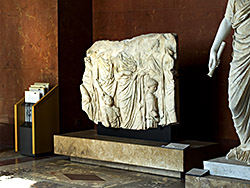
In the Louvre the Ara Pacis slab is exhibited close to the floor, at a level more appropriate for an ancient sarcophagus. Thus viewers are looking slightly down at the relief instead of from varying distances looking up, as Augustan viewers would have seen the original monument (see next image to right).
photo July 2012
|
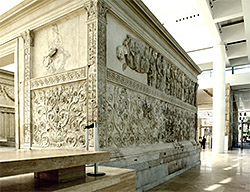
Scholars agree that the 1938 reconstruction of the Ara Pacis, preserved within the new Musée dell'Ara Pacis as seen here, approximates its original design. On the monument in the museum, the cast of the Louvre slab is located near the left side of the processional frieze, as seen in this photo.
photo July 2008
|
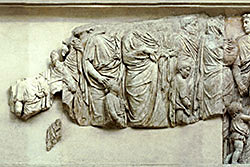
Augustan viewers would have been able to see the processional frieze almost straight on only when viewing from a distance. This photo of the cast on the Ara Pacis was taken from a considerable distance outside the museum, through tinted glass.
photo May 2010
|
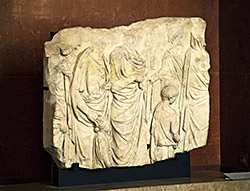
Louvre slab seen from slightly left showing 3-dimensional character of the relief. Zoom to examine important partial and damaged figure at far left.
photo July 2012
|
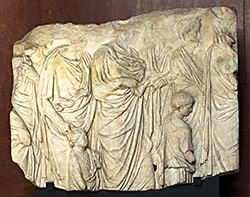
Louvre slab seen approximately straight on, looking very slightly down.
The identity of each of these figures has been debated by scholars.
photo July 2012
|
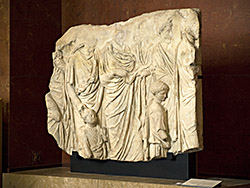
Louvre slab seen from slightly right.
Zoom to examine low relief of face at upper-right and other largely missing heads.
photo July 2012
|
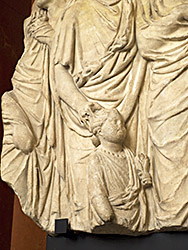
Left side of the Louvre slab.
Photo taken with camera on floor to approximate original view.
photo July 2012
|
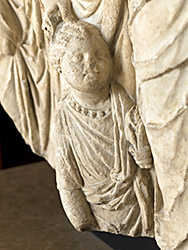
Young child seen almost full-face.
Her/his identity continues to be debated by scholars.
photo July 2012
|
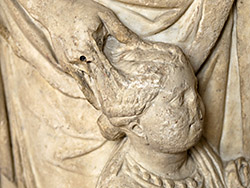
Although Augustan viewers would not have seen this child's head from above, we can see the hair style and firm touch of the toga clad man behind.
photo July 2012
|
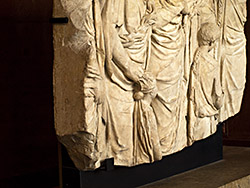
End and left side of the Lourve slab showing depth of this and other slabs as cut from the original large blocks of marble in 1568-69.
photo July 2012
|
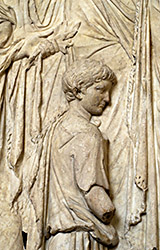
An especially well-preserved figure of an older boy. His identity continues to be debated by scholars.
photo July 2012
|
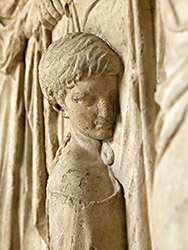
Face of an older boy seen almost full-face. Much of the original carving of the face is well preserved. Later infill is clearer than in black-white photographs. The partial merging of the head with the background is characteristic.
photo July 2012 |
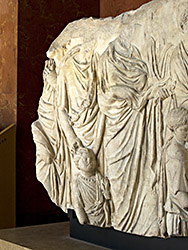
Left side of the Louvre slab seen from severe angle showing varying depths of relief.
photo July 2012 |
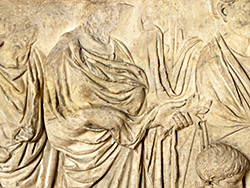
Figures, mostly headless, whose identification remains highly uncertain.
Woman in center holds laurel.
photo July 2012
|
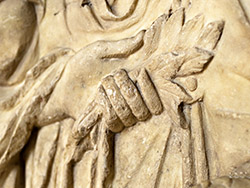
Well-preserved detail of woman's left hand holding laurel.
photo July 2012
|















